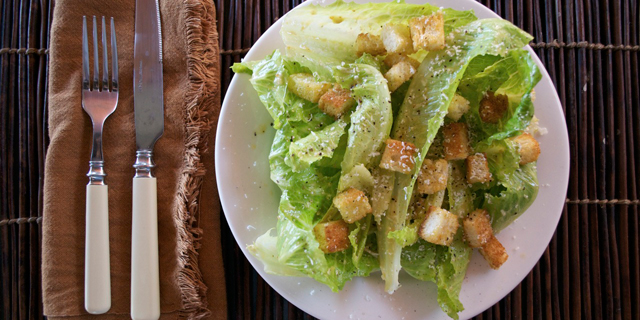In 1924, four years after those pesky prohibition laws were passed in the States and four years before the opening of the infamous Agua Caliente pleasure palace, Caesar Cardini invented the Caesar Salad in Tijuana, Mexico.
Surprised? Let’s continue. Though there are many claims to the origin of the ‘classic’ Italian salad, all stemming from Mexico or the United States, naturally, none is stronger or more documented than that of Mr. Cardini, an Italian immigrant living in San Diego, California.
Caesar, along with his brother, Alex, ran Caesar’s Restaurant in Tijuana during the 1920s. During that time, Prohibition and other US restrictions on casinos, gambling, and prostitution were godsends for Tijuana, where restrictions were lax, if even existent. During this time, Avenida Revolución, the town’s main drag and home to Caesar’s, was a never ending party that could put Gatsbyian revelries to shame. It was not uncommon to spot Charlie Chaplin or Fred Astaire sipping cocktails at one of the glamorous bars, or Al Capone and Bugsy Siegel making deals amongst the well heeled Mexicans and Americans escaping the city bustle for the weekend. The quirky, lovable mistress of French cooking, Julia Child, even wrote about vacationing in Tijuana with her family as a young girl, writing that her parents were so excited to finally be eating at the famous Caesar’s Restaurant.
Next, how to make your own Caesar salad…
[pagebreak]
Even with its great local success and worldwide fame, Caesar’s Restaurant fell on hard times in the 2000s. By 2009, gangs and drug lords had taking over Tijuana, scaring away tourists and locals alike. No longer a hot tourist destination, the current owners couldn’t manage it, and Caesar’s was set to close.
Enter Grupo Plascencia, a renowned restaurant empire run by Father Plascencia and four brothers, all Tijuana natives and strong supporters of the local economy with ventures in both Mexico and the US. When news of Caesar’s closing hit the group, Javier Plascencia, partner and world-renowned chef (right), called the ailing owners for a meeting. Like Ms. Child, he too had fond memories of going out for Caesar salads with his parents, and of being awed by the tableside preparation. Skilled whisking of egg and olive oil and Worcestershire. Heavy snows of Parmesan. Long spring-green romaine hearts. “I instantly loved it,” said the chef. Grupo Plascencia met with the previous owners, and that same day walked away with the keys to Caesar’s.
Next, get a taste of the classic salad…
[pagebreak]Grupo Plascencia started a major renovation that lasted almost a year, but by July 2010, Caesar’s was restored to its 1920s charm, and the Caesar salad was once again available tableside. Like a number of Chef Plascencia’s restaurants, everything at Caesar’s that can be sourced locally – from surrounding regions in Baja, Rosarito, and San Diego – is. “…our bread is home made, our eggs from a local farm, we use Mexican limes, and one of the most important ingredients, olive oil, is a special blend produced by us at Finca Altozano in the Valley” said the chef through an email. In addition to the Caesar, the group wanted to preserve other iconic Tijuana dishes, so Caesar’s menu also includes Costa Azul Shrimp from La Costa Restaurant, Victor’s Salad (like a Caesar but with cotija cheese and A1 sauce) from Victor’s Restaurant and “Mexican Caviar” from Bocaccio’s. Plascencia said, “The rest of the menu are all classic dishes, that just embody what it was like to go out to a fancy dinner in the past, like Beef Wellington, Oysters Rockefeller and Escargot.”
Today, with the help of Plascencia and other local, future-minded entrepreneurs, Tijuana is working on its image and reviving its downtown. Local government officials have launched tourist initiatives and are cracking down on crime, and the Baja city is slowly returning to its past glory as a leisure destination. Caesar’s Restaurant was the first restaurant to reopen on Avenida Revolución. Writing from Tijuana, Plascencia said, “For my family and I, it’s a great honor to be able to keep a place like this in Tijuana, because over the years we’ve seen so many classic restaurants close for one reason or another. Caesar’s is a part of our tradition, and [Grupo Plascencia] hopes to keep it in the family for many years to come.”
So, thanks to Plascensia and Grupo Plascencia, we’ll be able to “Hail Caesar! (Salad)” for many years to come.
*It’s worth noting that Alex, Caesar’s brother, also laid claim to the culinary invention, even going so far as to list it as “the original Alex Cardini Caesar salad” on his menus. A cook from Caesar’s Restaurant also says he invented it in 1925 and Caesar took it from him.
The New Caesar’s Restaurant Caesar’s Salad Recipe
- 1 head romaine lettuce
- 3/4 cup extra virgin olive oil
- 1 teaspoon Worcestershire sauce
- 1/4 tablespoon ground mustard
- 1 clove crushed garlic
- coddled egg
- 1 lime, juiced
- fresh ground black pepper
- 1/4 cup grated Parmesan cheese
- 4 sliced baguette oven baked garlic croutons


![Making Mealtime Matter with La Familia: Easy Sofrito [Video]](https://thelatinkitchen.com/wp-content/uploads/2015/10/sofrito-shutterstock__0-500x383.jpg)
![Easy Latin Smoothies: Goji Berry Smoothie [Video]](https://thelatinkitchen.com/wp-content/uploads/2015/12/goji_berry-shutterstock_-500x383.jpg)
















![Fun and Fast Recipes: Fiesta Cabbage Salad [Video]](https://thelatinkitchen.com/wp-content/uploads/2015/11/fiesta_cabbage_slaw-shutterstock_-500x383.jpg)









